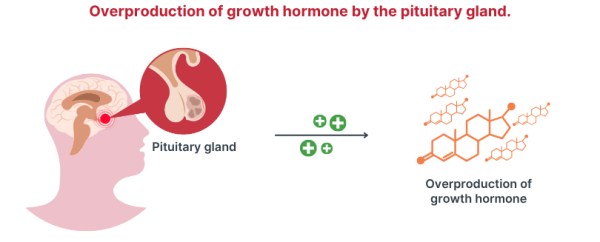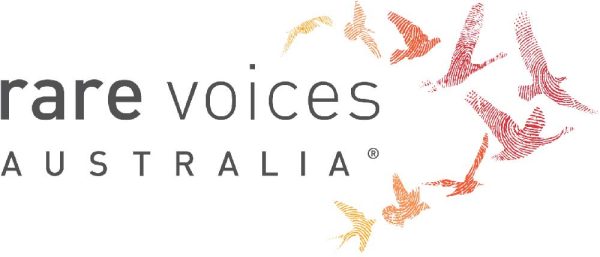Acromegaly
Quick Search
- Summary
- Synonyms and Classifications
- Symptoms
- Disability Impacts
- Cause and Inheritance
- Diagnosis
- Treatment
- Clinical Care Team
- Clinical Care Guidelines
- Emergency Management
- Research
- Rare Disease Organisation(s)
- Lived Experience
- Support Services and Resources
- Mental Health
- Other Information
- Useful Links for Healthcare Professionals
Summary
Acromegaly is a type of pituitary condition and is caused by the pituitary gland producing too much growth hormone (GH).1,2 In most cases, it is due to a non-cancerous (benign) tumour in the pituitary gland. GH is a hormone involved in many biological processes in the body, including physical growth, and stimulating the liver to produce insulin-like growth factor-1 (IGF-1).3 Too much production (overproduction) of GH leads to abnormal growth of bones, resulting in enlarged hands, feet, and facial features, as well as thickening of soft tissues like the heart, lips, and lungs.1,3 It can also lead to curvature of the spine and enlargement of internal organs.3 There is also a range of other symptoms, including joint and muscle pain, high blood pressure (hypertension), headaches, issues with vision, as well as metabolic complications, such as high blood sugar and type 2 diabetes associated with increased IGF-1 levels.3 If the overproduction of GH occurs in childhood before puberty, the condition is known as gigantism instead of acromegaly, and results in tall stature.1-3 Symptoms of acromegaly tend to develop slowly over time, which makes it hard to recognise and is often only diagnosed years after the initial onset.1,3-4

Synonyms and Classifications
There are no known synonyms.
Universal rare disease classifications provide a common language for recording, reporting and monitoring diseases. Please visit the Rare Disease Classifications page for more information about these internationally recognised classifications.
Symptoms
Symptoms of acromegaly often develop slowly and may not be noticeable for years.1-4 There is a wide range of symptoms, which may vary between individuals.3
Common physical symptoms of acromegaly include large hands, feet and facial features such as nose, jaw, lips, tongue and wide spacing between front teeth.1,3 Individuals may also have abnormal curvature of the spine, outgrowth of the skin (skin tags), excessive sweating and oily skin as well as enlarged thyroid (goiter).3 There may also be enlargement of internal organs such as the liver (hepatomegaly), spleen (splenomegaly), heart, intestines, kidney and adrenal glands.3
General signs may include joint and muscle pain, tiredness, snoring, headache and issues with vision.1 There may also be other complications, including but not limited to:1,3
- inflammation of joints (osteoarthritis) and carpal tunnel syndrome
- high blood pressure (hypertension)
- high blood sugar (glucose) levels and Type 2 diabetes
- heart disease
- sleep apnea
- erectile dysfunction in men and infrequent menstrual periods (oligomenorrhea) in women
- abnormal tissue growth (polyp) in colon and increased risk of colon cancer
Please speak to your medical term to learn more about the signs and symptoms of acromegaly.
Disability Impacts
Rare diseases are often serious and progressive, exhibiting a high degree of symptom complexity, leading to significant disability. Majority of the estimated two million Australians living with a rare disease meet the Australian Government’s definition for disability (in accordance to the Australian Public Service Commission and Australian Bureau of Statistics), and many experience severe and permanent disability impacts. If you or someone you care for is experiencing disability-related impacts from a rare condition, please speak with a health or disability professional for advice. Information about relevant disability support can be found at the RARE Portal’s Disability Support Information page.
Cause and Inheritance
Acromegaly is caused by the pituitary gland producing too much growth hormone (GH). It is most often related to a pituitary gland tumour that is usually non-cancerous (benign). In rare cases, overproduction of GH may be caused by tumours in the pancreas, lungs, adrenal glands or in the hypothalamus of the brain.2,3

Acromegaly may also occur as part of genetic syndromes such as types of multiple endocrine neoplasia syndromes, familial isolated pituitary adenoma (FIPA), Carney complex or McCune-Albright Syndrome.3,4
Diagnosis
Diagnosis of acromegaly may be made based on detailed patient history, clinical examination and blood tests to detect increased levels of insulin-like growth factor (IGF-1) and growth hormone (GH).3,4 Measurement of GH should be done together with a glucose tolerance test – known as a growth hormone suppression test.1 Blood GH levels are measured before and after a glucose drink that should lower GH levels if the pituitary gland is functioning properly.1,3
Imaging studies such as magnetic resonance imaging (MRI) or computerised tomography (CT) may be used to detect for, and visualise, any tumours.1,3,4 Further tests may be performed to determine the extent of acromegaly symptoms/disease presentation. This may involve a heart ultrasound (echocardiogram), sleep studies to identify sleep disorders such as sleep apnea, bowel exam (colonoscopy) and eye field tests to detect for vision issues.1,4
Please speak to your medical team to learn more about the available diagnostic pathways for acromegaly.
Treatment
There is currently no curative treatment for acromegaly. Treatment is targeted at reducing growth hormone (GH) levels and at managing symptoms (symptomatic management) but is unable to reverse bone growth.1 Treatment may first involve surgery to remove or reduce any tumours and/or medication to block or reduce GH levels.1,3,4 Radiotherapy tends to only be used as the third line of treatment as it may take years to achieve a result.1,3 Regular monitoring of endocrine function is required.5
Please speak to your medical team to learn more about the possible treatment or management options for your condition. Treatment will depend on an individual’s specific condition and symptoms. It is also important to stay connected to your medical team so that you can be made aware of any upcoming clinical trial opportunities.
Clinical Care Team
Clinical care for rare diseases often involves a multidisciplinary team of medical, care and support professionals. Please note that the information provided here is as a guide and that RVA does not necessarily monitor or endorse specific clinics or health experts.
Healthcare professionals involved in the treatment of acromegaly may include general practitioners (GP), endocrinologists, endocrine nurses, neurosurgeons, neuroradiologists, neuropathologists, and radiation oncologists.1,5 The need for different healthcare professionals may change over a person’s lifetime and extend beyond those listed here.
Hormones Australia: Find An Endocrinologist is a directory of endocrinologists across Australia who are members of the Endocrine Society of Australia. A referral from a GP is required to see an endocrinologist.
Clinical Care Guidelines
Multidisciplinary management of acromegaly: A consensus was published in 2020 by the Acromegaly Consensus Group consisting of acromegaly experts from various countries, including Australia.
Emergency Management
Individuals living with rare diseases may have complex medical issues and disabilities, which are not always visible. It is often useful to refer to their medical history as well as personal information such as a medical card, doctor’s letter, or if available, a rare disease passport, for relevant information.
Research
There are specific considerations around participating in rare disease research, including clinical trials. It is important to be mindful of issues such as data privacy, research ethics, consent and differences in research regulations between Australia and other countries.
If you are interested in finding clinical trials for your condition, please visit the following websites; however, there may not be any clinical trials available:
It is best to discuss your interest in any clinical trials with your medical team to determine suitability and eligibility.
Please note that RVA does not necessarily monitor or endorse each group/organisation’s operational governance and activities.
Rare Disease Organisation(s)
Australian Organisation:
Australian Pituitary Foundation
Website: https://pituitary.asn.au/
Australian Pituitary Foundation (APF) is a national not-for-profit organisation, established to provide valuable support and information for adults and children, along with their families, living with pituitary conditions.
Please note that RVA does not monitor or endorse each group/organisation’s operational governance and activities. When engaging with a group, please consider the information on the RARE Portal’s Finding Helpful Peer and Community Supports page.
Lived Experience
Acromegaly varies between individuals, and each person’s experience is unique.
Please visit Australian Pituitary Foundation: Shari’s story to read a personal story of living with acromegaly.
If you would like to share your personal story with RVA, please visit the Rare Voices Australia: Share Your Story page. RVA will consider your story for publishing on our website and inclusion on the RARE Portal.
Support Services and Resources
For information on available government and social services that provide support for individuals with a rare disease, please visit the National and State Services pages.
Mental Health
People living with a rare disease, including families and carers, often face unique challenges such as diagnostic delays, misdiagnoses, limited treatment options, and limited access to rare disease specialists and support. These challenges may impact people’s emotional wellbeing and quality of life. Many people find it helpful to seek mental health and wellbeing support to cope with ongoing stress and uncertainty. Connecting with people who have shared experiences through a support group may also be helpful. Information about relevant mental health and wellbeing support can be found at:
- Mental Health and Wellbeing Support for Australians Living with a Rare Disease
- The National and State Services pages underneath the ‘Mental Health’ sections listed
Other Information
Further information on acromegaly and general information on pituitary conditions can be found at:
Useful Links for Healthcare Professionals
- Australian Pituitary Foundation: Information for GPs
- Endocrine Society of Australia (ESC) – national non-profit organisation of scientists and clinicians who conduct research and practice in the field of Endocrinology
- Endocrine Nurses’ Society of Australasia Inc. (ENSA)
- Australia and New Zealand Society for Paediatric Endocrinology and Diabetes (ANZSPED)
- Human Phenotype Ontology (HPO): Acromegaly (ORPHA:963)
References
- Australian Pituitary Foundation. A guide to acromegaly. 2023. 4 p. https://pituitary.asn.au/wp-content/uploads/2023/09/APF-Acromegaly-Fact-Sheet-2023_Digital-Final.pdf
- Genetic and Rare Diseases (GARD) Information Center. Acromegaly. Accessed 19 October 2023. https://rarediseases.info.nih.gov/diseases/5725/acromegaly
- National Organization for Rare Disorders (NORD). Acromegaly. Accessed 19 October 2023. https://rarediseases.org/rare-diseases/acromegaly/
- Orphanet. Acromegaly. Accessed 19 October 2023. https://www.orpha.net/consor/cgi-bin/OC_Exp.php?lng=EN&Expert=963
- Giustina A, Barkhoudarian G, Beckers A, et al. Multidisciplinary management of acromegaly: A consensus. Rev. Endocr. Metab. Disord. 2020; 21(4):667-678. https://doi.org/10.1007/s11154-020-09588-z
Contributors
This page has been co-developed by Rare Voices Australia (RVA)’s RARE Portal team in consultation with Australian Pituitary Foundation.
If you are aware of any additional information that may benefit stakeholders with an interest in this page, or if you notice any broken links or inaccurate information, please let us know via the Contribute page.

